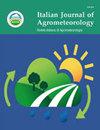不同土壤、水分和气候条件下栽培藏红花的产量和质量及生化特性
IF 1.6
4区 农林科学
Q2 AGRONOMY
Italian Journal of Agrometeorology-Rivista Italiana Di Agrometeorologia
Pub Date : 2021-12-27
DOI:10.36253/ijam-1216
引用次数: 2
摘要
藏红花因其独特的香气、味道、颜色和药用特性而受到高度重视。伊朗是最重要的藏红花生产国之一。本研究旨在探讨6个产地(Shirvan、Faruj、Zavareh、torbate Heydarieh、Ghayen和Birjand)的气候和环境特征对藏红花产量、质量和生化特性的影响。所研究的部位被认为是治疗。获得的数据基于嵌套设计进行分析,其中站点内的村庄被认为是实验误差,每个站点内的村庄中的农场被认为是抽样误差。海拔~1323.3 m的Torbat-e Heydarieh处理的藏红花花产量最高(0.83 g m2),柱头产量最高(0.098 g m2),藏红花素含量最高(15.8%),微番红花素含量最高(30.6%),藏红花素含量最高(69.3%)。显然,该地区夏季最高气温较低是其优势的原因之一。性状间相关分析表明,夏季最高温度与藏红花花产量、柱头产量、藏红花素和藏红花素含量呈显著负相关。结果表明,黄酮类化合物、酚类化合物含量和DPPH活性最高的品种为石首菜和法鲁菜。虽然结果表明硒可以提高藏红花的定量和定性产量,但这需要进一步的研究来证实。综上所述,1)藏红花的定性和定量特征受环境和气候条件的强烈控制;2)拉萨维省在花和柱头产量以及藏红花、微藏红花素和藏红花素含量方面具有显著优势,而北呼罗珊省在生化特征方面具有显著优势。本文章由计算机程序翻译,如有差异,请以英文原文为准。
Yield and qualitative and biochemical characteristics of saffron (Crocus sativus L.) cultivated in different soil, water, and climate conditions
Saffron is highly valued for its unique aroma, taste, color, and medicinal properties. Iran is one of the most important saffron-producing countries. The present study aimed to investigate the effect of climatic and environmental characteristics of six sites (Shirvan, Faruj, Zavareh, Torbat-e Heydarieh, Ghayen, and Birjand) on the yield and qualitative, and biochemical characteristics of saffron. The studied sites were considered as treatments. The obtained data were analyzed based on a nested design, where the village within the site was considered an experimental error, and the farm within the village within each site was considered a sampling error. The Torbat-e Heydarieh treatment with altitudes of ~1323.3 m produced the maximum saffron flower yield (0.83 g m2), stigma yield (0.098 g m2), safranal content (15.8%), picrocrocin content (30.6%), and crocins content (69.3%). Evidently that the low maximum summer temperature in the area is one of the reasons for its superiority. The correlation analysis between traits shows that the maximum summer temperature had a significant negative correlation with saffron flower yield, stigma yield, and picrocrocin and crocin content. Results showed the highest total flavonoid and phenol content and DPPH activity related to Shirvan and Faruj. Although the results showed that selenium could increase the quantitative and qualitative yield of saffron, this requires further studies to confirm it. Based on the findings, it is concluded that I) qualitative and quantitative characteristics of saffron are strongly controlled by the environmental and climatic conditions and II) Razavi Khorasan province had a significant advantage in terms of flower and stigma yield and safranal, picrocrocin and crocin content of saffron and North Khorasan province in terms of biochemical characteristics.
求助全文
通过发布文献求助,成功后即可免费获取论文全文。
去求助
来源期刊

Italian Journal of Agrometeorology-Rivista Italiana Di Agrometeorologia
AGRONOMY-ENVIRONMENTAL SCIENCES
CiteScore
2.10
自引率
8.30%
发文量
6
期刊介绍:
Among the areas of specific interest of the journal there are: ecophysiology; phenology; plant growth, quality and quantity of production; plant pathology; entomology; welfare conditions of livestocks; soil physics and hydrology; micrometeorology; modeling, simulation and forecasting; remote sensing; territorial planning; geographical information systems and spatialization techniques; instrumentation to measure physical and biological quantities; data validation techniques, agroclimatology; agriculture scientific dissemination; support services for farmers.
 求助内容:
求助内容: 应助结果提醒方式:
应助结果提醒方式:


